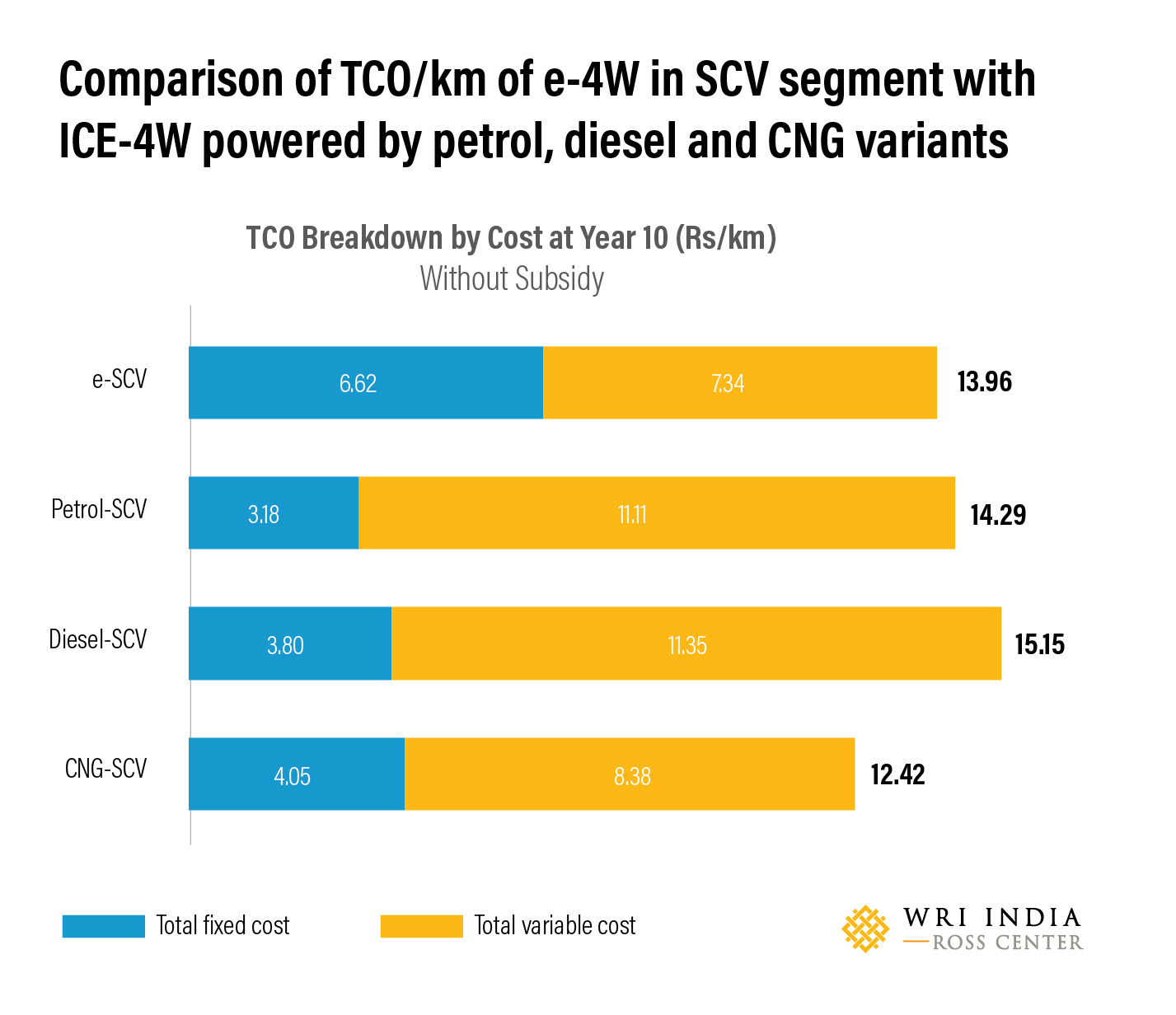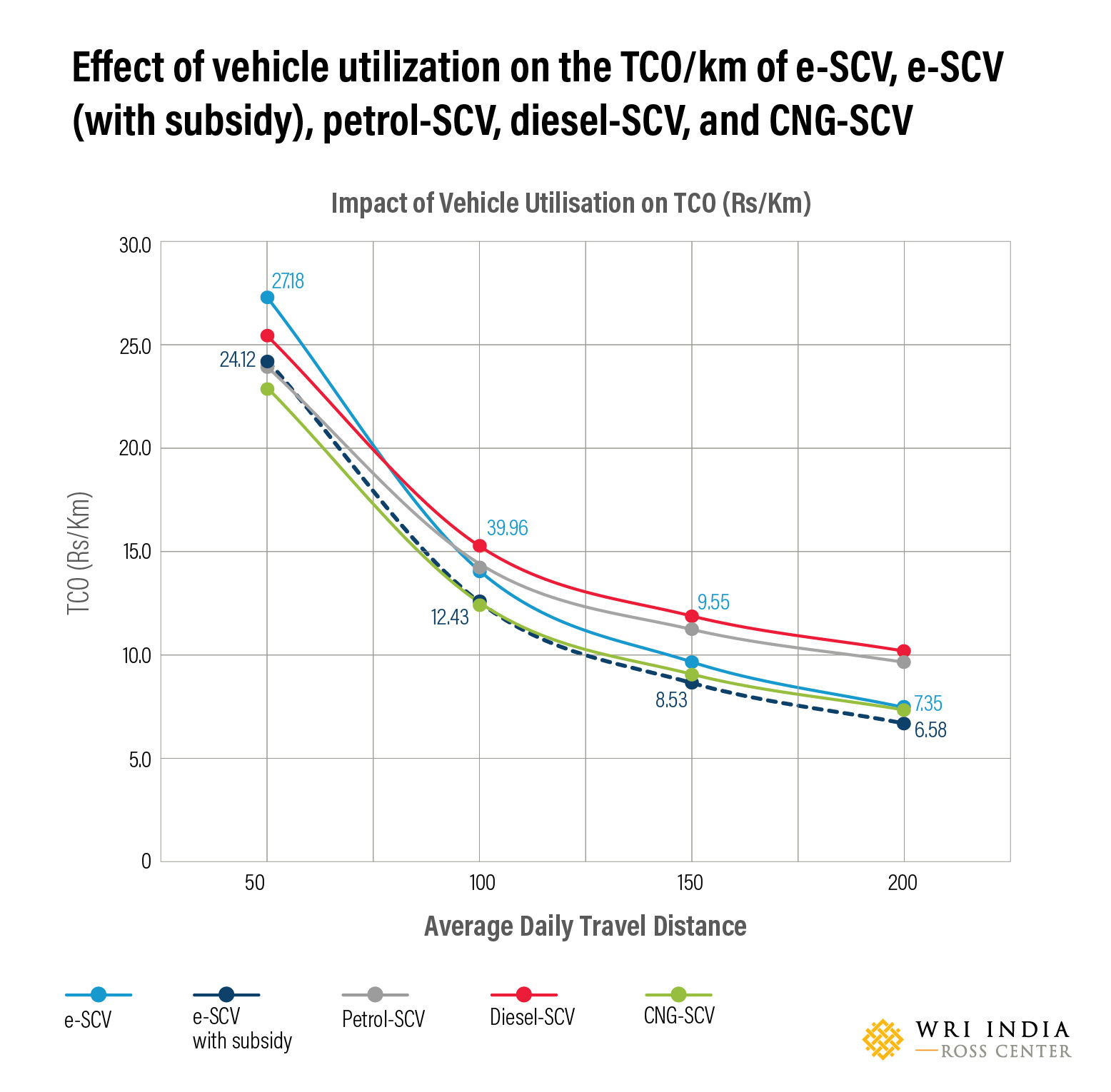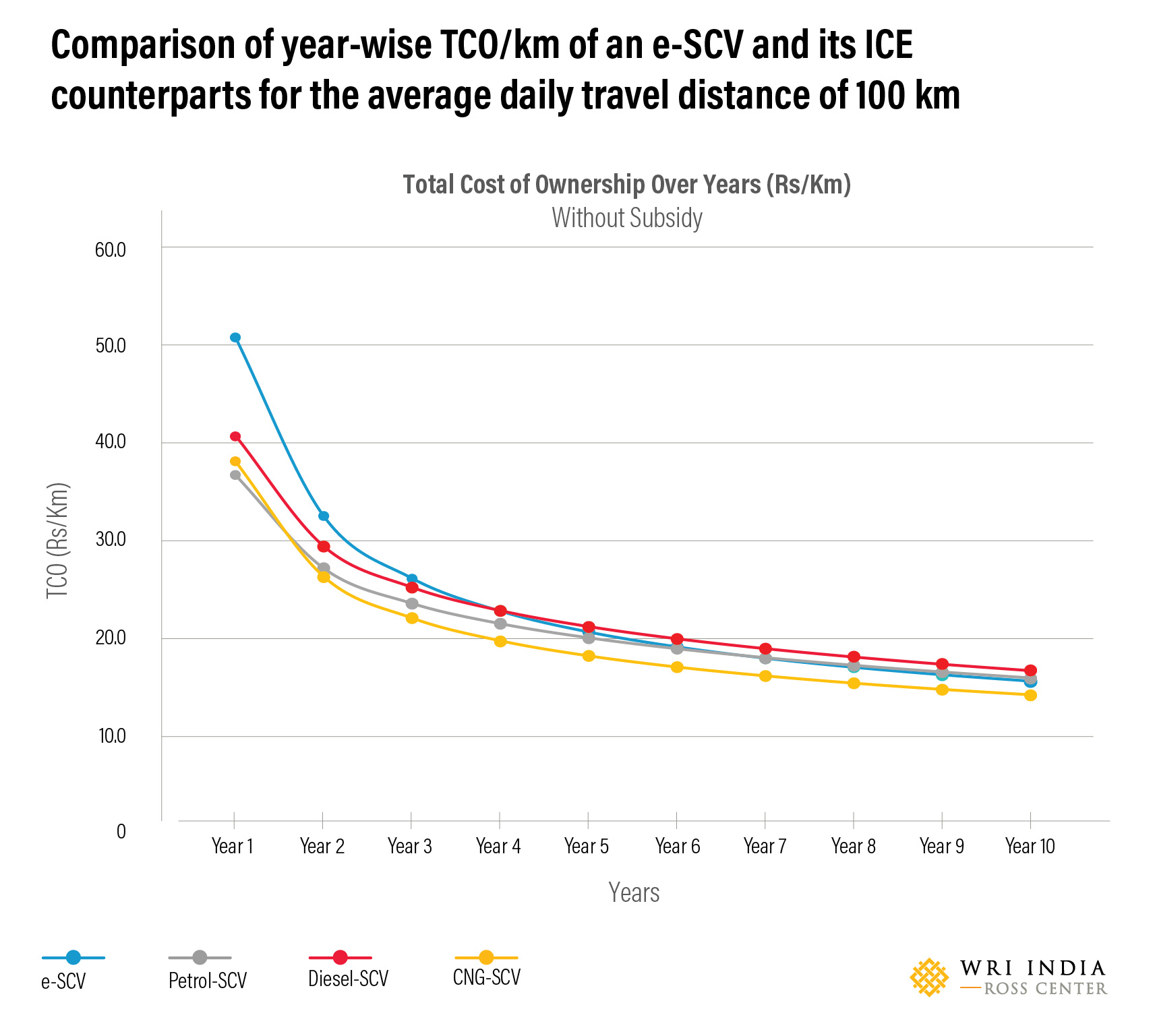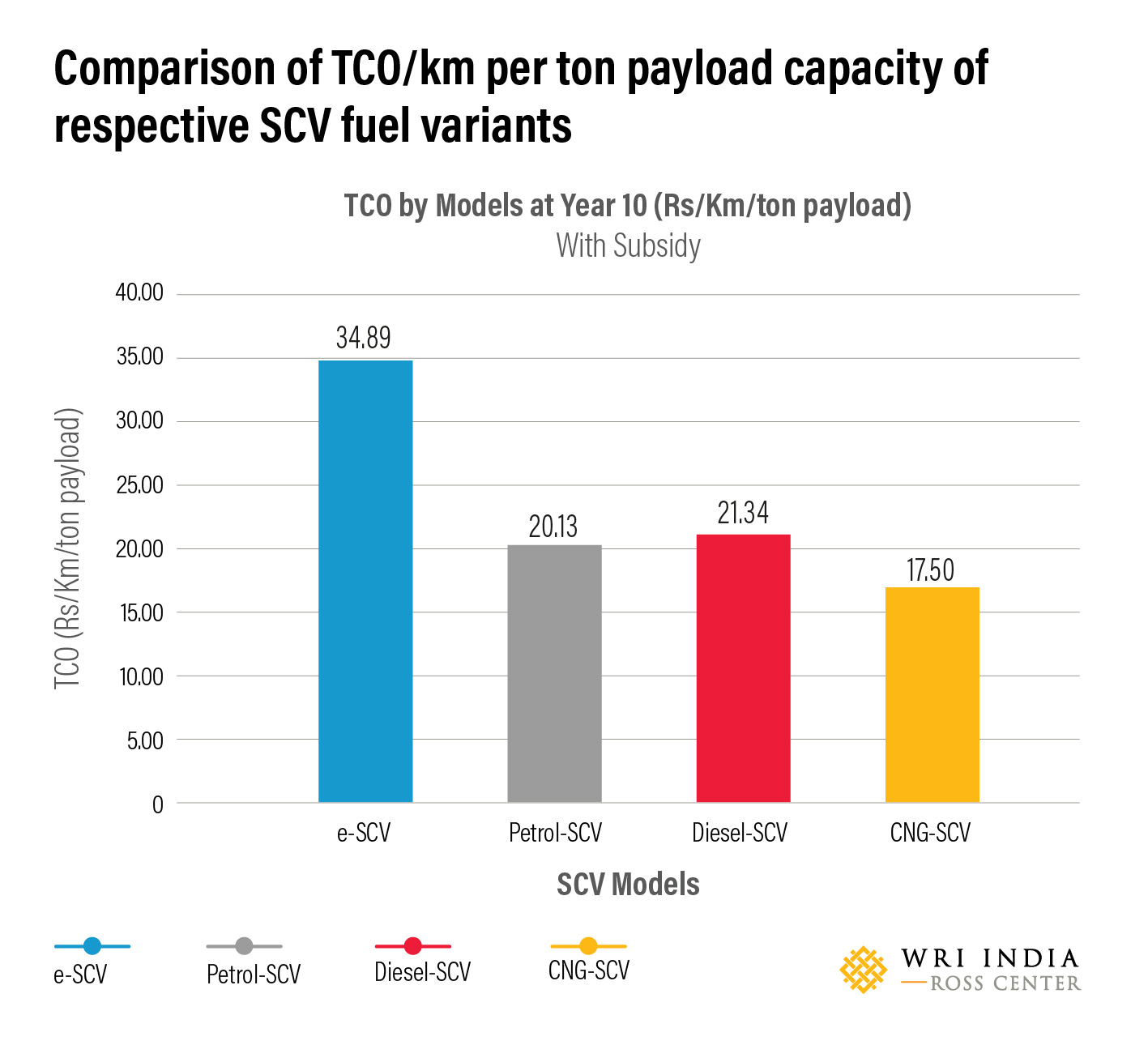Accelerating Electrification of Small Commercial Freights in India
by , and -
Tata Motors recently unveiled a comprehensive range of 21 new commercial vehicle models across different segments with an emphasis on its ‘Power of 6’ program. In line with this strategy of low-emission and high productivity, they are working on developing multiple small electric variants catering to last-mile distribution of goods. In FY2019, this small commercial vehicle (SCV) segment contributed to Seventy-three percent of the total commercial vehicle sales. The compound annual growth rate (CAGR) was 10% from FY2015 to FY2019 and is further expected to grow with a CAGR of 8% for the next five years. In the same period, its market increased from INR 26,000 crores (USD 3.5 billion) to INR 39,000 crores (USD 5.2 billion). Reiterating the increasing demand for short-haul freights, a recent study from The Energy and Resources Institute (TERI) suggests 4-wheeler SCV segment could be Seventy-six percent of the total stock of SCVs by 2030.
With increased consumer demands, particularly for same-day deliveries, e-commerce is undergoing a paradigm shift. This evolving demand has significantly reshaped the logistics sector, especially in the last-mile delivery SCV segment.
With the share of BS-VI compliance being low, 4-wheeler SCVs are best poised for rapid electrification. A 14% reduction in Carbon dioxide (CO2) emissions is attainable in this segment. Furthermore, the scrappage policy and higher renewal fee of old vehicles could create more traction towards clean mobility.
Electrification of SCVs: Current Status and Market Potential
A limited number of e-SCV models are available in the 4-wheeler segment, including Mahindra e-Supro, Croyance Electro 1.t, and T3-cargo van from BYD-India. E-Trio, an Indian Original Equipment Manufacturing company specializing in retrofitment of existing internal combustion engines to convert them to EVs have launched their first electric commercial model, a retrofitted Tata Ace, which is powered by a 20 kilowatt-hour (kWh) battery and has a certified range of 120 kilometers on a single charge.
On the demand side, online retail and logistics giants like Amazon, IKEA, UPS have committed to incorporate EVs into their commercial fleet. Amazon India now operates at least 100 electric vehicles across seven cities. As part of the company’s global commitment to operating at least 100,000 electric vehicles by 2030, they have pledged to increase it to 10,000 by 2025. Flipkart, too, has committed to deploying some 25,000 electric vehicles by 2030 for their last-mile delivery by partnering with manufacturers like Hero, Mahindra Electric, and Piaggio.
In addition to Central government initiatives, several state governments have also earmarked specific subsidies to support the electrification of freight. The Delhi government, for example, provides an interest subvention of 5% on loans and a purchase incentive of INR 30,000 for the first 10,000 e-Carriers registered in the city. Karnataka has set a target to transition 100% of its 4-wheeler mini trucks to electric by 2030. The Haryana government plans to phase out fossil fuel-powered logistics vehicles in Gurugram and Faridabad by 2024, and in other cities by 2030.
Economic viability of e-SCVs
In the Total Cost of Ownership (TCO) analysis for the SCV segment, we considered lithium-ion battery (LIB) powered e-4W and compared it with 4-wheeler Internal Combustion Engine variants powered by compressed natural gas (CNG), petrol, and diesel.
Figure 1 (a) compares the TCO per kilometer for these models considering an average utilization of 100 kilometers per day in last-mile delivery in urban areas. The TCO/kilometer of e-SCV is lower than that of petrol and diesel 4-wheeler Internal Combustion Engines but higher than that of CNG variants. With FAME-II subsidy of INR 2,40,000, the TCO/kilometer of e-SCV decreases to INR 12.43, which is comparable to the CNG variant.
Figure 1 (b) shows that with increasing vehicle utilization, the economic viability of e-SCV significantly improves compared to ICE variants. At a daily travel distance above 100 kilometers, the TCO per kilometer of e-SCV with FAME-II subsidy becomes less than even CNG vehicles.


With an average daily use of 100 kilometers the TCO/kilometer of an e-SCV achieves break-even with diesel SCV by the fourth year, even without FAME subsidies. This leads to significant savings by the end of ten years which is the usual holding period of an SCV.

TCO Calculations Per Ton Payload Carrying Capacity

In the freight segment, one of the biggest challenges is the reduction in payload capacity of electric variants due to the battery’s weight. For example, the fossil fuel variants of Tata Ace can carry payload tonnages of up to 0.71 tons, whereas equivalent e-SCV (E-Trio) can only carry around 0.4 tons. Lower payload means e-SCVs might have to undertake additional trips to compensate, reflecting in the higher TCO per kilometer per ton, which on average is 48% and 54% more than diesel and petrol variants, respectively.
Summary and Key Recommendations
An incremental, multiple stakeholder executable approach to electrifying the SCV segment with key actions and fiscal interventions is critical to unlocking its potential.
Promote scrapping or retrofitting: Most SCVs in the country are obsolete, not well-maintained, and don’t conform to BS-VI standards. This makes them inefficient and highly polluting. These vehicles should either be scrapped or retrofitted with ARAI certified kits.
Generate interest/risk sharing mechanisms: State governments should create time-bound policy roadmaps in conjunction with private players to increase the deployment of e-SCVs. This can be achieved by working with banks and financial institutions to secure favourable loan tenures with lower interest rates.
Charging infrastructure and battery swapping: Installing charging points on high volume corridors can alleviate range anxiety and instill confidence in fleet operators. Battery swapping technology decouples the cost of battery from that of vehicle, thereby reducing high upfront costs. In addition, the range can be extended by swapping batteries at ease with lighter batteries, increasing the load-carrying capacity of freights.
India is on the cusp of a significant transition in freight sector, and electrification of small commercial vehicles supplemented by creating an enabling policy and regulatory environment for its adoption could unlock sizeable economic, environmental benefits and help in accelerating the decarbonization of the transport sector.
Views expressed are personal.


